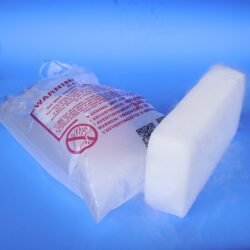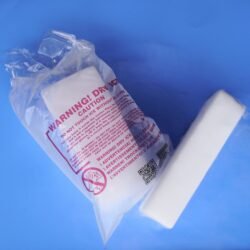Dry ice is a powerful asset in the modern restaurant. From preserving perishable ingredients to adding a dramatic flair to cocktails and plated dishes, its versatility is unmatched. Whether used in the kitchen or front-of-house, dry ice in restaurant environments offers creative possibilities—but also introduces real safety risks.
This frozen form of carbon dioxide isn’t just cold—it’s dangerous when mishandled. In a bustling kitchen or catering setup, failing to implement proper safety procedures can lead to frostbite, equipment damage, or worse—oxygen displacement that puts your team at risk.
In this guide, we’ll walk through the complete safety and storage protocol for using dry ice in foodservice settings.
What Is Dry Ice and Why Restaurants Use It
Dry ice is the solid form of carbon dioxide (CO₂), frozen at a staggering -78.5°C (-109.3°F). Unlike water-based ice, it sublimates — meaning it turns directly from solid to gas, skipping the liquid phase entirely.
For restaurants, that makes it invaluable. Here’s how chefs, managers, and foodservice professionals use dry ice every day:
- Cocktail presentation: Think swirling fog over a bourbon sour or dry martini.
- Event service: Keep chilled desserts or oysters cold without melting water.
- Ingredient transport: Maintain cold chain compliance for frozen proteins, gelato, or seafood.
- Emergency refrigeration: During power outages or equipment failures, dry ice keeps perishables safe.
- Culinary innovation: Quick-freezing sauces, herbs, or fruits using flash-cooling techniques.
Its benefits are bold — but so are its risks.
Safety Risks Associated with Dry Ice
Dry ice may look harmless, but improper handling can lead to serious injuries or environmental hazards. Every restaurant using dry ice should understand the core risks.
Frostbite and Skin Damage
Touching dry ice with bare hands can freeze skin cells instantly. Even brief exposure causes burns similar to open flame contact.
CO₂ Buildup and Asphyxiation
As dry ice sublimates, it releases CO₂ gas. In enclosed areas like walk-in pantries, transport vans, or low-ventilation kitchens, CO₂ can displace oxygen and lead to dizziness, disorientation, or unconsciousness.
Pressure and Explosion Hazard
If dry ice is sealed inside an airtight container, the gas buildup can lead to a dangerous explosion. Never store dry ice in sealed buckets, bottles, or freezers without airflow.
Eye Injuries
Breaking or chipping dry ice without goggles can result in particles flying into the eyes, causing severe damage.
Treat dry ice with the same caution you would handle fire, chemicals, or heavy kitchen machinery. It is not a toy — and in the wrong hands, it’s a threat.
Regulatory Guidelines
To ensure restaurant staff and guests are protected, regulatory bodies have clear safety guidelines for dry ice.
OSHA Standards
The Occupational Safety and Health Administration (OSHA) mandates:
- Clear labeling of hazardous substances like CO₂
- Use of personal protective equipment (PPE) such as gloves and eye protection
- Proper ventilation in storage and prep areas
- Training for all employees who may handle or come into contact with dry ice
Local Health Departments
Depending on your location, your local health department may require:
- Ventilated storage for dry ice
- Written safety procedures
- Proper signage in dry ice zones
- Staff certifications or proof of training
Check your local food code and integrate its requirements into your restaurant SOPs.
Handling Dry Ice Safely
The safest way to handle dry ice is to respect its temperature and pressure. Here’s what every restaurant should require when it’s used on-site.
PPE for Dry Ice Handling
- Insulated gloves: Never touch dry ice directly
- Safety goggles: Protect from shards when chipping blocks
- Long-sleeve clothing or aprons: Prevent forearm or torso exposure
- Tongs or scoops: Always handle indirectly
Staff Training Protocol
- Incorporate dry ice handling into your onboarding
- Post signage with visual safety instructions
- Train staff to monitor dry ice use during high-volume hours
Your kitchen may already have safety protocols for cleaning chemicals or heat. Treat dry ice with the same level of discipline — especially if front-of-house staff are using it in cocktail service or guest-facing plating.
Storing Dry Ice Properly
This section tackles the heart of dry ice usage in foodservice and naturally integrates every core keyword.
How Do You Store Dry Ice?
The most effective way to store dry ice is inside a vented insulated cooler, preferably one designed specifically for dry ice storage. These coolers maintain low temperatures while allowing CO₂ gas to escape safely.
Thick Styrofoam containers can be used if no dry ice-specific options are available. The priority is always ventilation and insulation.
Where to Store Dry Ice in a Restaurant
Store dry ice in:
- A back-of-house location that’s well-ventilated
- An insulated cooler marked with “DRY ICE – DO NOT TOUCH”
- Away from HVAC intakes, gas burners, or direct sunlight
Avoid storing dry ice in:
- Sealed closets or cabinets
- Walk-in coolers without CO₂ monitors
- Near prep stations where food is handled raw
Can You Store Dry Ice in a Freezer?
Absolutely not. If you’re wondering, “can you store dry ice in a freezer?”, here’s the truth:
- Dry ice is far colder than your commercial freezer’s design limits
- It can shut down your compressor, crack internal components, or destroy insulation
- It causes freezer damage and voids most warranties
Freezers are not a safe or suitable option for dry ice storage.
Ventilation and Air Quality
Poor ventilation is the hidden threat that most restaurants overlook when using dry ice. But the risks can be deadly.
Why Airflow Matters
As dry ice sublimates, it releases carbon dioxide gas. In small or enclosed areas, CO₂ replaces oxygen — leading to dizziness, shortness of breath, or unconsciousness. This can happen without warning and in as little as 10 minutes in a sealed environment.
Best Practices for Air Safety
- Never store dry ice near air returns or closed vents
- Use CO₂ detectors if you store large quantities
- Crack doors or use extractor fans in tight spaces
- Avoid using dry ice in rooms under 200 square feet without ventilation
If you’re using dry ice regularly in your restaurant, consider investing in air quality monitoring equipment or consult your HVAC provider for airflow testing.
Signage and Communication
Visual cues are one of the most effective ways to reinforce dry ice safety. In a busy kitchen, even trained staff can forget best practices under pressure. That’s where signage becomes essential.
Where to Place Signage
- Near dry ice storage containers
- At entrances to rooms where dry ice is handled
- On delivery coolers brought into the building
- In prep areas where dry ice may be used for presentation
What to Include on Signage
- “CAUTION: DRY ICE – DO NOT TOUCH”
- “USE GLOVES AND TONGS”
- “VENTILATION REQUIRED IN THIS AREA”
- Emergency instructions and numbers
You can also add QR codes linking to digital safety training or your restaurant’s internal SOPs for quick reference.
Clear signage reduces liability and reinforces your safety-first culture. If your restaurant accepts deliveries or hosts events where dry ice is used offsite, portable signage is also recommended.
Disposal of Dry Ice
Disposing of dry ice incorrectly is one of the most common and dangerous mistakes restaurants make. The best disposal method is always controlled sublimation.
Safe Disposal Methods
- Leave remaining dry ice in a well-ventilated area, away from people and pets
- Allow it to fully sublimate (turn into gas)
- Use metal trays or dry ice bins with vented lids for safe containment
What Not to Do
Never dispose of dry ice in:
- Sinks or dishwashers
- Toilets or floor drains
- Trash cans or recycling bins
- Commercial compactors
Doing so can damage plumbing systems and release CO₂ into confined spaces. Make it part of your closing checklist to account for leftover dry ice before staff leave for the night.
Common Mistakes to Avoid
Even experienced staff can make critical mistakes with dry ice if safety isn’t top of mind. Avoid the following:
Storing Dry Ice in Sealed Containers
This can cause explosive gas buildup.
Putting Dry Ice in Walk-In Freezers
It’s too cold — compressors shut down and internal parts crack.
Handling Without Gloves or Tongs
Skin contact results in frostbite. Always use PPE.
Using Dry Ice in Sealed Spaces
No ventilation = high CO₂ levels. This is especially dangerous in catering vans or storage closets.
Leaving It Where Guests Can Touch It
Dry ice cocktails may look impressive, but guests should never come in contact with dry ice directly. Always supervise service.
Emergency Procedures
If something goes wrong, response time matters. Here’s how to respond to dry ice-related incidents:
Burns or Frostbite
- Remove any dry ice from the skin
- Rinse the area with lukewarm (not hot) water
- Do not rub or massage the skin
- Apply a sterile bandage and seek medical attention
CO₂ Exposure
- If someone appears dizzy or disoriented, move them to fresh air immediately
- Open doors and windows to ventilate the space
- Call emergency services if symptoms persist
- Check CO₂ monitors, if available, for readings above safe thresholds
Having these steps printed and posted near your dry ice station helps staff react quickly and confidently.
Training and Compliance
One of the most overlooked parts of dry ice safety is training — especially for part-time or seasonal employees.
Integrate Dry Ice Safety into SOPs
- Add a dry ice handling section to your kitchen handbook
- Train all BOH and FOH staff who may interact with dry ice
- Reinforce protocols during shift meetings and onboarding
Schedule Quarterly Refreshers
Keep staff up to date on safety practices and make it a team habit. Review real examples of mistakes, even if they happened offsite or in other restaurants.
Maintain Compliance Records
If your local health department audits your storage practices or asks for documentation, having training logs, safety signage, and SOPs on file shows that you take safety seriously.
Final Tips for Restaurant Managers
Dry ice is one of the most powerful, versatile tools in a restaurant — but it demands control. Train your staff well, label everything clearly, ventilate your spaces, and never store dry ice in the freezer.
Use containers designed for dry ice storage, keep clear signage in place, and avoid improvising when handling a substance this extreme. Every step you take toward safety is a step toward smoother service and lower liability.
If you need food-grade dry ice delivered directly to your restaurant with insulated containers and proper packaging, SubZero Dry Ice is here to help.
Conclusion
Dry ice can elevate your restaurant’s presentation, extend your cold chain capabilities, and offer creative culinary options. But it only works when it’s handled safely. From how to store dry ice to understanding why you shouldn’t store dry ice in a freezer, knowing the risks is the key to protecting your staff and business.
Whether you’re using dry ice for dramatic cocktail service or emergency refrigeration, always prioritize safety, training, and preparation.
Ready to order food-safe, properly packaged dry ice for your restaurant?
Contact SubZero Dry Ice for Same-Day Delivery →
FAQs
How long does dry ice last in a restaurant?
Dry ice typically lasts between 18–24 hours in an insulated container. The more you open it, the faster it sublimates.
Can you store dry ice in a freezer?
No. Dry ice is too cold and can damage your freezer’s internal systems. Use insulated coolers instead.
Where should I store dry ice in my restaurant?
Store it in a well-ventilated, non-airtight container in a designated back-of-house area, away from food and flames.
How do I dispose of dry ice safely?
Allow it to sublimate in a ventilated area away from staff, customers, or animals. Never place it in plumbing or sealed trash containers.
How can I tell if my storage area is properly ventilated?
Install a CO₂ monitor or work with your HVAC provider to evaluate airflow. If using large volumes of dry ice, this step is critical for safety.





